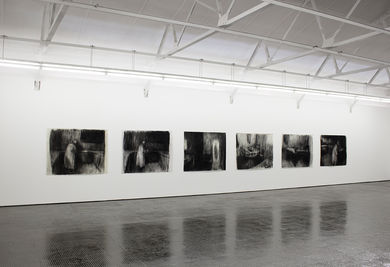JOHANN LOUW
Gestaltes
EXHIBITION TEXT
Solo Exhibition
20.11.14 – 17.01.15
Cape Town
Gestaltes is Johann Louw’s fourth solo exhibition with SMAC Gallery. Best recognized for his expressive paintings, this exhibition is the first to comprise solely of charcoal drawings.
Studies of abandoned domestic scenes, nude and abject figures bent over or prostrated on the floor, ever-looming balloons, and animals caught at the moment when one would usually look away. In Gestaltes, these charged representations of forms and animals evoke the surreal and somewhat romantic language of the source of the exhibition title, Afrikaans poet and playwright N.P. van Wyk Louw’s 1942 anthology of poetry titled Gestaltes en Diere.
Continuing with his exploration of the enigmatic, Louw’s drawings of frozen moments seem to flicker through his tense, gestural mark-making and use of negative space. Depicting both lack and excess, there is a haunting in these stark, monochromatic compositions. There is also irony in Louw’s movement away from the rational through a focus on the predominantly every day, highlighting that which is often concealed and unseen.
This hyper awareness of his surroundings – whether imagined or real – suggests an interest in consciousness; a state of awareness or being aware of an external object or something within oneself. Johann Louw’s engagement with states of being, and the ability to experience and to feel, is both inward and outward looking. The animals act as metaphors and metonyms for the viewer to engage with. Figures are studied in relation to, and as a potential consequence of, their environment. The balloons, drawn from the Russian and Soviet Filmmaker, Andrei Tarkovsky’s, film stills, conjure up notions of transcendence and surpassing the ordinary. The relationships between the different works are productive yet unclear, and narratives are unknown or hidden from the viewer. Layered with references and foci, memories and fictions, the drawings emphasize ambiguity and a search for meaning.With this uncertainty, comes a suggested destabilizing of consciousness and a move into a confusing, more dreamlike state.
In this regard, Sigmund Freud’s notion of the uncanny (or unheimlich), as an instance where something is simultaneously familiar and foreign, is a significant element of these drawings. Freud’s concept of the uncanny and his interpretation of dreams had a significant influence on the Surrealist movement and their depiction of the unnatural and strange. Though the concept of the uncanny is not easily definable, Freud explored numerous instances which may give rise to feelings of the uncanny; such as animism, sorcery, repetition and the double. Freud connected these disparate examples through the ambiguous nature of the German word Heimlich, which relates to that which was meant to remain hidden and secret, but has been revealed. The uncanny then may be seen in Johann Louw’s recurring use of plastic masks, the deathly still figures, the tension between the known and the unknown, and his dislocated landscapes. As Freud stated, an “uncanny effect is often and easily produced when the distinction between imagination and reality is effaced, as when something that we have hitherto regarded as imaginary appears before us in reality” (1990:369).
Uncanniness may arouse fear and doubt but, as experienced when viewing Johann Louw’s work, also interest. The secretly familiar, although unsettling, encourages curiosity, engagement and a felt response; the conscious and subconscious collide. Attention is drawn to the experience of viewing itself, as a voyeur, conspirator or the dreaming subject.
Sigmund Freud, “The Uncanny,” (1919) in Collected Works, vol. 14 (London, UK: Penguin, 1990).




















































